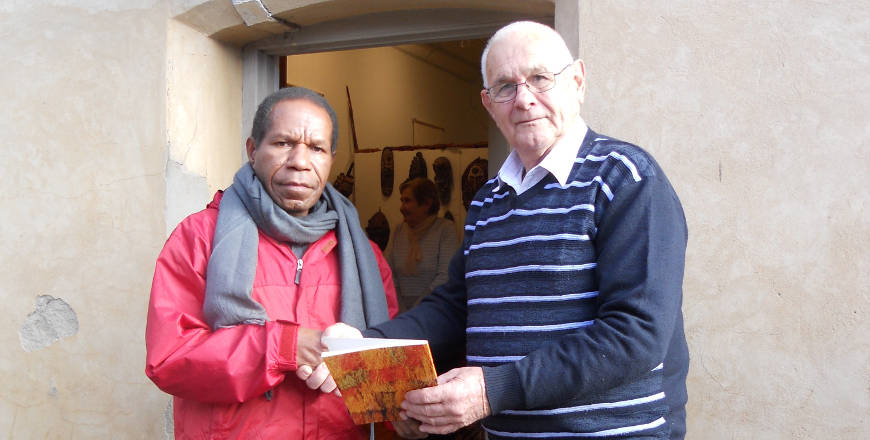Have you ever imagined being a museum caretaker, waiting for the sun to go down in the hope that ancient artefacts come alive? Imagine this fantasy world within a tiny museum in the Adelaide Hills housing thousands of extremely rare and valuable antiquities, dating back to pre-Christian times. The real-life caretaker of this museum, John […]
Have you ever imagined being a museum caretaker, waiting for the sun to go down in the hope that ancient artefacts come alive?
Imagine this fantasy world within a tiny museum in the Adelaide Hills housing thousands of extremely rare and valuable antiquities, dating back to pre-Christian times.
The real-life caretaker of this museum, John Schultz, may not have to contend with nocturnal antics, but he still maintains a close affinity with the story-filled pieces in his museum collection, which celebrates and preserves the culture and heritage of Papua New Guinea and other mission fields. It is a legacy which began in 1886, when Johann Flierl, the very first Lutheran missionary, arrived on Papua New Guinea’s shores.
John, himself a 10-year veteran of the Papua New Guinean mission fields, has catalogued each and every item in the collection. These artefacts have largely been collected by the Lutheran Church’s faithful past and present missionaries and their families.
From metre-long hand-carved wooden storyboards depicting Christ’s death and resurrection, to items of pagan sorcery, the items range from utensils used in daily living to art forms from centuries past.
As 78-year-old John generously shares the story of how this mission museum came to be, you soon realise that the truth of his story is more amazing than any Hollywood fiction. For it is a story of how God’s love, shared with our neighbours, has brought many people into God’s family. This is the story told through many of the exquisite museum exhibits.
They tell a real story of how Australian missionaries shared the gospel with the indigenous people, training up local evangelists to spread God’s word across the country.
Today Papua New Guinea is home to more than 1.5 million Lutherans.
‘It was the New Guineans themselves who spread the news of God’s love’, John says.
Also compelling are the real stories of the 600 or so Australians who served as Lutheran missionaries (along with Germans, Americans and Canadians) since 1886.
The museum houses many pieces lovingly shared by many of them.
John is familiar with that journey, having spent a decade serving in Papua New Guinea from 1961. He married his wife Maryn there, and they returned to Australia in 1970 with three children. They celebrated their 55th wedding anniversary in May this year.
John, a member of the Nairne congregation of St Paul’s Hahndorf parish, has been involved in the museum, named after Johann Flierl’s wife Louise, since it was opened in 1998. It was started by Christel Metzner, wife of former Lutheran Director for Missions, Pastor Ulf Metzner.
Christel is the one who gathered the treasure-trove, including reading notes to describe many of the items, along with the donors’ names.
‘It is very hard to know how old some of the exhibits are, as there are no records of when some of the items were made’, John says. ‘People come and tell us they have never seen anything like some of these items.’
For many years the museum, which relies on volunteer support, opened three afternoons a week. It was staffed by ex-missionaries or others associated with the Papua New Guinea mission fields. Over time, John has become the only one left to look after it. It now opens several times a year by appointment.
John has photographed and catalogued every single item in the museum in his voluntary role, handling each precious artefact.
‘The way it is set up, it doesn’t require much attention, just general housekeeping. We’re really proud of it and for its type, it’s world class’, John says.
‘The collection goes through pre-Christian times and includes items of sorcery and magic that people adhered to in those days, through to artwork, mainly in wood carving, masks and village scenes. It goes through the stories of the missionaries coming.’
The museum also shares the stories of the Bible translation services undertaken, mainly in three local languages, which served to capture the main languages of the coastal areas where the missionaries were first based.
‘It takes on average 10 to 14 years to translate the Bible into a language – and quite often that is only the New Testament’, he says.
Hahndorf’s St Paul’s parish owns the building housing the unique museum and will provide it rent free for the next three years, when it will then need to find a new home.
‘We are very grateful they have given us that opportunity’, John says.
The Committee for International Mission, which oversees the museum, is working to find a new future venue.
John has been trying for the past five years to find an understudy who can take on the caretaking role, which is challenged by the lack of younger people serving in Papua New Guinea in the same way as in past years.
However, he is confident that the museum’s role in preserving this heritage for the future will continue. He would love to see it combined with an Australian Aboriginal mission collection of artefacts from the areas where Lutherans missionaries have served as well.
His confidence in the future is backed by his faith in God. Just like his wedding text from Proverbs, he simply trusts in the Lord, who directs our paths. ‘And boy, have our paths been directed’, he says.
Reprinted with kind permission of The Lutheran. Visit the website to find out more about The Lutheran or to subscribe.
The museum is open Wednesdays from 10.00am to 4.00pm. Bookings for Wantok Place can be made for group visits, by emailing wantok-place@lca.org.au or by phoning the museum manager, Timothy Pietsch, on 08 8267 7410. Visit the website for more information at www.lca.org.au/wantok-place


0 Comment